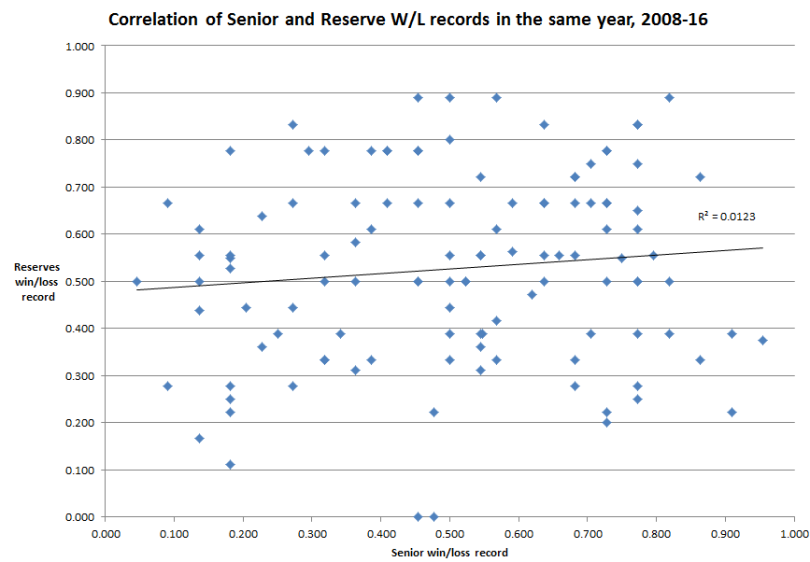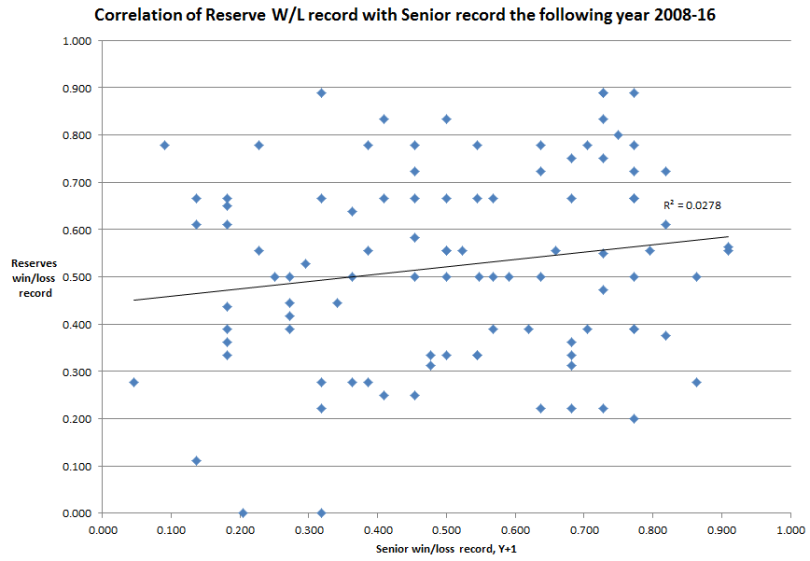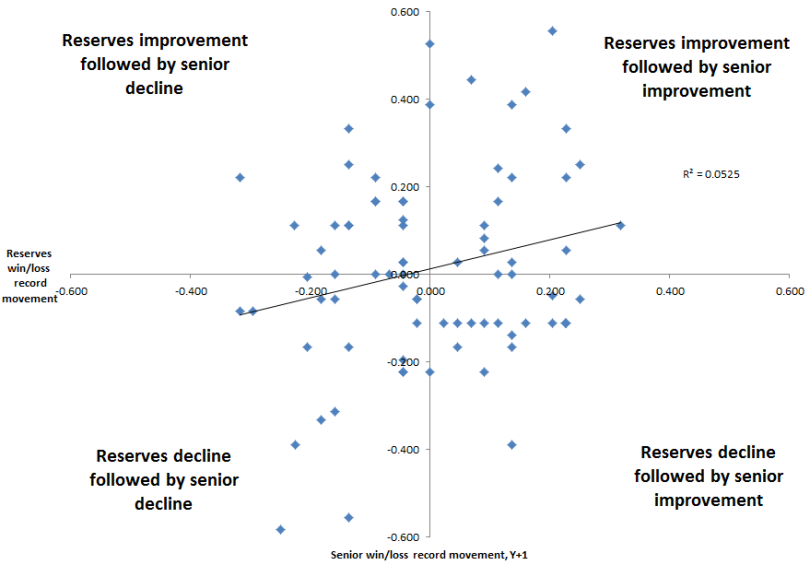It’s VFL, SANFL, WAFL and NEAFL finals season as well as AFL season and for several teams, their reserves are the only team still in the hunt for premierships. Fremantle’s Peel Thunder feeder club rolled West Coast’s East Perth this weekend just gone, while in Victoria the reserves of Melbourne (Casey), Essendon, and St Kilda (Sandringham) remain in the hunt. Does the success of these teams tell us anything about the futures of these clubs? Similarly, does Brisbane’s reserve grade woes predict future pain for the Lions?
Maybe.
Below is a chart of reserve and senior win-loss results since 2008, in terms of regular season win-loss records.

The higher a dot, the better the reserves record. The further right, the better the senior record. As we can see there’s a weak positive correlation between how teams perform in a given year.
By the way, the dataset here covers one-to-one relationships between senior and reserve grade sides in the current four state competitions. It excludes pre-2014 WAFL and SANFL arrangements, northern sides pre-2011 (the foundation of the NEAFL), and North Melbourne pre-2016 due to their dual reserves arrangement with Werribee and Ballarat.
We should probably assume that reserves performance tells us more about how a senior team is likely to go in future than how they’re going currently. So let’s time-shift the data points so that they represent the senior year following a reserves season:

That’s looking a touch more predictive, but still quite a weak correlation. While intuition tells us a good reserves team should develop into a good senior team, there is a lot of noise to clear out even if this is true.
Now let’s look at movement changes between years.

This is where we think the trend really shows. There’s a definite positive trend line among the noise, but still with significant outliers. This probably makes sense. There’s a lot of reasons why reserve and senior trends can diverge. Those might include:
- A decent senior team lacks depth or, while still performing well, sustains a lot of injuries.
- A team has a strange list profile (perhaps a lot of underdeveloped talls) that is not conducive to competitive reserves performances.
- Clubs likely have access to different quality non-AFL players. The NEAFL sides, for example, usually use underage academy players. Weeks when those players are required for representative duties, their reserves teams suffer (cf. Brisbane and Gold Coast in the past two years).
- Clubs might have very good, or very poor, coaching and development at reserve level.
- The non-AFL structures at clubs may differ – the partnerships in the VFL where the side is not a pure subordinate of the AFL team can complicate development, or can be strong independently from the senior team. Melbourne, for instance, hasn’t had a better senior season than Casey have in our sample.
Regardless, this positive correlation is there. Fans of teams whose reserves are flying can plausibly choose to believe that brighter things are in store for their senior sides. That especially goes for St Kilda and Melbourne.
Finally, here’s graphs of all 18 team’s records. For a closer look, click to enlarge. We’ve included North’s two affiliates here.
Week 1 Finals Preview
Geelong v Hawthorn
Geelong come into the game as favourites, and the two key reasons appear to be the strength of their midfield and the weakness of Hawthorn’s defense. We’ve broken down a few of the indicators that we’ve used throughout the season here:

Both sides seem to be similarly potent when they get the ball inside their forward 50, but they appear to score in slightly different ways. Geelong has the most marks inside-50 per inside-50 entry of the finalists, while Hawthorn are second-last in the same category. Geelong has a lot of potent talls in their forward line (such as Tom Hawkins) that live and die on the contested mark. Hawthorn, by contrast, have a number of players (Bruest, Gunston, Rioli, Sicily) leading their attack who are equally adept in the air or on the ground.

Geelong have a definite advantage in defence, with a very accomplished backline, and effective strategy down back. Hawthorn, on the other hand, seem to be cobbled together out of spare parts and gumption. Again, Geelong seem to be a better side in the air defensively than the Hawks, but their size and height may also suggest an issue with Hawthorn’s fast small forwards, especially in the wet.

Hawthorn relies more on moving the ball by foot, and has a slightly higher rate of uncontested disposals to contested – a stylistic difference more than anything. Geelong, however, has a significant edge in generating inside 50 opportunities, and a slight edge in the ruck.
Sydney v GWS
This game should be a battle between styles (to a degree). Will the dominant Sydney defence be able to overcome GWS’ balance?

GWS have had a more potent attack this year, but this is obscured by the absence of Tippett for Sydney, and the resultant structural changes they have had to make. Sydney’s recent upward trend (finally ticking above league average) in scoring efficiency may suggest they’re better than their whole-season record in this department.

We wrote earlier this week that Sydney has the best defence of the last 18 years, and by a fair way. GWS have the second best defence of all finalists, but there’s a definite gap in how well they prevent scores inside their defensive-50.

Again, one side (the Giants) rely much more heavily on moving the ball by foot. Both sides have near identical inside 50 ratios, with GWS having the edge in the ruck.
The key for GWS to cause an upset will be to win the midfield battle, and expose the strong Sydney defence to repeat inside 50 entries.
Adelaide v North Melbourne
Most people are assuming this one is a foregone conclusion, but there might be a little fight left for North. At least that’s what all neutrals looking for a good game are hoping for.

Again, we wrote about how good the Crows attack has been earlier this week. But for the early part of this year, North weren’t too far away from them in ability. Unfortunately for Kangas fans, a big part of that early potency, Jarrad Waite, is sitting on the sidelines this week.

If there’s an Achilles heel for this Adelaide side, it is their defence of opponent inside-50s. Both sides have near identical defence ratings according to HPN, and that’s about as close as the Crows have to a weakness.

There’s also a potential mismatch looming in the ruck, with Goldstein appearing as a potential saviour for North, as long as his midfield is up to the task. Both sides seem similar stylistically, with Adelaide improving as the year went in relation to their inside-50 ratio.
There’s at least a glimmer of hope there for North, which has been enough before in September.


















